Chinese Green Tea
Chinese Green Tea: Freshly invigorating, crisp, leaving a delicate lingering sweetness.

Chinese green tea, renowned for its delicate flavor and health-promoting properties, boasts a history spanning over 4,000 years. Originating during the reign of Emperor Shennong in 2737 BCE—a mythical figure credited with pioneering herbal medicine—Green Tea was initially valued for its medicinal benefits. By the Tang Dynasty (618–907 CE), it became integral to Chinese culture, celebrated in Lu Yu’s The Classic of Tea, the world’s first treatise on tea. The Ming Dynasty (1368–1644 CE) later perfected steaming and pan-firing techniques to halt oxidation, preserving its vibrant green hue and fresh, grassy notes. Today, varieties like Longjing (Dragon Well) and Bi Luo Chun remain symbols of China’s enduring tea heritage, reflecting centuries of refinement in cultivation and craftsmanship.
 The Grades of Green Tea
The Grades of Green Tea
· Mingqian tea
Mingqian tea(明前茶) refers to the tea leaves picked before the Qingming Festival, which usually falls around April 4th or 5th in the Gregorian calendar. The Qingming Festival is an important traditional Chinese festival that marks the beginning of spring plowing and tomb-sweeping. According to legend, during the Qingming Festival, the weather is clear and bright, and the tea trees are in full bloom, producing the most tender and flavorful tea leaves.
Mingqian tea is highly prized for its freshness, delicacy, and rich aroma. Due to the limited picking period and the small yield, Mingqian tea is relatively expensive and is often regarded as a luxury item. It is known for its light green color, mellow taste, and long-lasting aftertaste. When brewed, the tea leaves unfold gracefully in the water, releasing a fragrant aroma that fills the air.
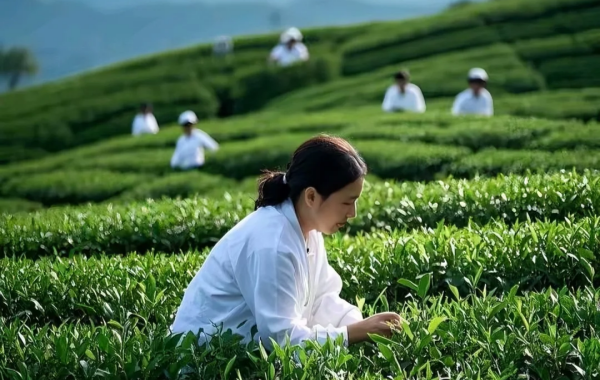
· Yuqian Tea
Yuqian tea(雨前茶) is picked before the Grain Rain Festival, which usually occurs around April 19th or 20th. The Grain Rain Festival is the sixth solar term in the traditional Chinese calendar, indicating the end of spring and the beginning of summer. During this time, the temperature rises and the rainfall increases, providing favorable conditions for tea tree growth.
Yuqian tea is slightly later in picking time compared to Mingqian tea, but it still retains good quality. The tea leaves are larger and more mature than Mingqian tea, but they still have a fresh and sweet taste. Yuqian tea is more affordable than Mingqian tea and is a popular choice for daily tea drinking. It has a bright green color, a strong aroma, and a refreshing taste that can help relieve fatigue and quench thirst.
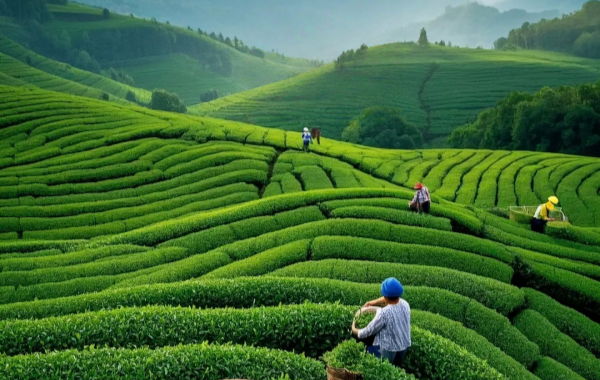
 The Production of Green Tea
The Production of Green Tea
Stir-Frying (Chaoqing,炒青)
Stir-frying is one of the most common methods of green tea production in China. It involves heating the tea leaves in a hot pan to stop the oxidation process and preserve the green color and fresh flavor of the tea. There are several types of stir-fried green tea, including long stir-fried green tea, round stir-fried green tea, flat stir-fried green tea, and curly stir-fried green tea.
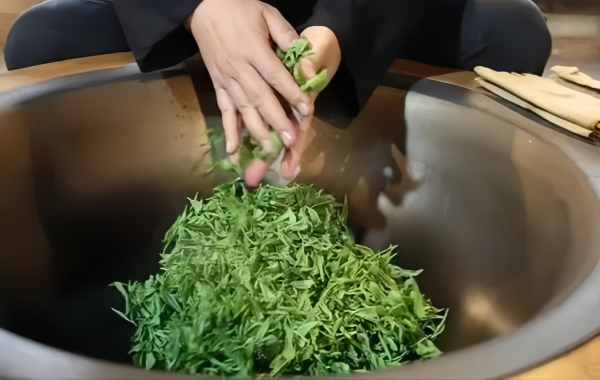
· Long Stir-Fried Green Tea(长炒青): This type of tea is characterized by its long and slender shape. During the stir-frying process, the tea leaves are continuously tossed and rolled in the pan to form a straight and tight appearance. Long stir-fried green tea has a fresh and mellow taste, with a light green infusion. Examples include Xinyang Maojian and Taiping Houkui (in a broader sense, as Taiping Houkui has its unique shaping process but also involves stir-frying).
· Round Stir-Fried Green Tea(圆炒青): Round stir-fried green tea is made by rolling the tea leaves into small round balls during the stir-frying process. This gives the tea a unique appearance and a concentrated flavor. When brewed, the tea balls gradually unfold, releasing their aroma and taste slowly. Zhuyeqing tea can be considered to have some round-shaping elements during processing, and it has a fresh and sweet taste with a bright green color.
· Flat Stir-Fried Green Tea(扁炒青): Flat stir-fried green tea is known for its flat and smooth shape. The most famous example is West Lake Longjing tea. During the production process, the tea leaves are pressed flat in the pan using a special technique, resulting in a unique appearance and a delicate flavor. West Lake Longjing tea has a light green color, a chestnut-like aroma, and a mellow and sweet taste.
· Curly Stir-Fried Green Tea(卷曲炒青): Curly stir-fried green tea is made by curling the tea leaves into various shapes during the stir-frying process. This gives the tea a more complex appearance and a rich flavor profile. Biluochun tea is a typical example of curly stir-fried green tea. It has a tightly curled shape, like a snail, with a white down covering the surface. Biluochun tea has a strong floral aroma and a fresh and brisk taste.
Roasting (Hongqing, 烘青)
Roasting is another method of green tea production that involves drying the tea leaves using hot air or charcoal fire. This process helps to remove excess moisture, enhance the aroma, and improve the storage stability of the tea. There are several types of roasted green tea, including strip-shaped tea, pointed-shaped tea, flake-shaped tea, and needle-shaped tea.
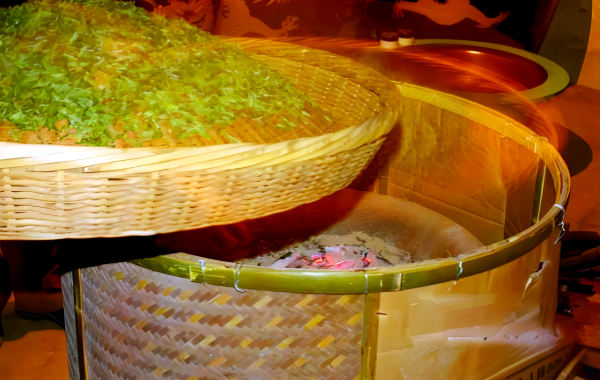
· Strip-Shaped Tea(条形茶): Strip-shaped roasted green tea has a long and narrow shape, similar to strips. During the roasting process, the tea leaves are arranged in a thin layer and dried slowly to maintain their shape and flavor. This type of tea has a fresh and mellow taste, with a light green infusion. Examples include some high-quality Huangshan Maofeng teas that may undergo a certain degree of roasting for flavor enhancement.
· Pointed-Shaped Tea(尖形茶): Pointed-shaped roasted green tea is characterized by its pointed and slender shape. The tea leaves are carefully shaped during the production process to achieve a uniform appearance. This type of tea has a delicate aroma and a smooth taste. Some fine Anji Bai Cha teas may have a pointed shape after roasting, and they are known for their fresh and sweet taste with a pale yellow-green infusion.
· Flake-Shaped Tea(片形茶): Flake-shaped roasted green tea is made by rolling the tea leaves into small flakes during the production process. This gives the tea a larger surface area, allowing for faster infusion and a stronger flavor. Flake-shaped green tea is often used in tea bags for convenience. Some lower-grade green teas may be processed into flake shape through roasting, and they have a relatively strong taste and a dark green color.
· Needle-Shaped Tea(针形茶): Needle-shaped roasted green tea has a long and thin shape, like needles. The production of needle-shaped green tea requires high skills and precise control of the roasting temperature and time. This type of tea has a fresh and elegant aroma and a mellow taste. Some high-end green teas, after special processing and roasting, can achieve a needle-like shape and offer a unique drinking experience.
Steaming (Zhengqing, 蒸青)
Steaming is a traditional method of green tea production that originated in China and was later introduced to Japan. It involves steaming the fresh tea leaves to inactivate the enzymes and prevent oxidation. The "three-green rule" is a characteristic feature of steamed green tea, which refers to the deep green color of the tea leaves, the light green color of the tea infusion, and the green color of the tea residues.
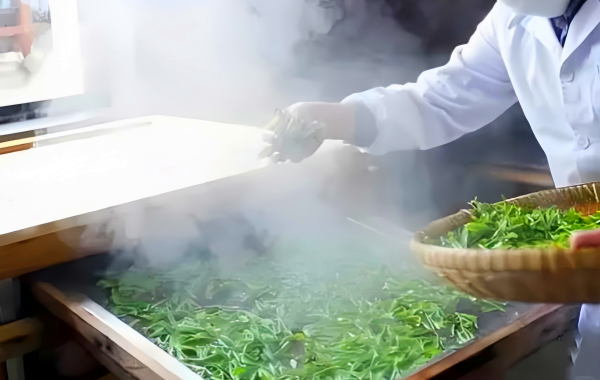
During the steaming process, the tea leaves are exposed to high-temperature steam for a short period, which helps to preserve the natural nutrients and fresh flavor of the tea. Steamed green tea has a unique aroma and taste, with a slightly grassy and vegetal note. It is often described as having a fresh and clean flavor profile. In China, although steaming is not as widely used as stir-frying and roasting, there are still some regional teas that adopt this method, such as some local teas in the southwestern regions.
Sun-Drying (Shaiqing, 晒青)
Sun-drying is a natural method of green tea production that utilizes sunlight to dry the tea leaves. This method is simple and environmentally friendly, and it can bring out the unique flavor of the tea. There are several types of sun-dried green tea, including Dianqing (from Yunnan), Chuanqing (from Sichuan), Qianqing (from Guizhou), Guiqing (from Guangxi), and Eqing (from Hubei).
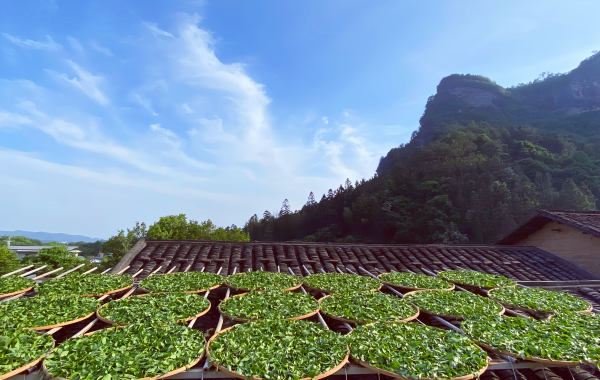
· Dianqing(滇青): Dianqing tea is produced in Yunnan Province. Yunnan has a unique geographical environment and climate conditions, which are suitable for tea tree growth. Dianqing tea is made from large-leaf tea varieties, and it has a strong aroma and a full-bodied taste. The sun-drying process gives Dianqing tea a natural sweetness and a long-lasting aftertaste.
· Chuanqing(川青): Chuanqing tea comes from Sichuan Province. Sichuan is known for its rich Tea Culture and diverse tea varieties. Chuanqing tea is characterized by its fresh and mellow taste, with a light green infusion. The sun-drying method helps to retain the original flavor of the tea leaves, making Chuanqing tea a popular choice among tea lovers.
· Qianqing(黔青): Qianqing tea is produced in Guizhou Province. Guizhou has a mountainous terrain and a humid climate, which provide favorable conditions for tea tree cultivation. Qianqing tea has a unique aroma and a smooth taste, with a slightly sweet note. The sun-drying process enhances the natural fragrance of the tea, making it a delightful beverage.
· Guiqing(桂青): Guiqing tea comes from Guangxi Province. Guangxi has a warm and sunny climate, which is ideal for sun-drying tea. Guiqing tea has a fresh and brisk taste, with a light green color. It is often enjoyed for its refreshing qualities and is a great choice for daily tea drinking.
· Eqing(鄂青): Eqing tea is produced in Hubei Province. Hubei has a long history of tea production, and Eqing tea is one of its representative products. Eqing tea has a delicate aroma and a mellow taste, with a bright green infusion. The sun-drying method gives Eqing tea a unique flavor that is different from other types of green tea.
The Producing Areas and Varieties of Green Tea
China can be divided into four main green tea producing areas: the Southwest, the South China, the East China, and the North of Huai River. Each area has its unique geographical location, climate conditions, and tea varieties, resulting in a wide range of green tea products with distinct characteristics.
Territory: Sichuan, Chongqing, Yunnan, Guizhou, Southeast Tibet
Terroir Advantages: This area is considered the oldest tea-producing region in China and is widely recognized as the origin of the world's tea trees. The high altitude, abundant rainfall, and fertile soil provide ideal conditions for tea tree growth. The region is known for producing high-quality mountain tea, which is characterized by its strong aroma, full-bodied taste, and rich nutritional content.
Core Famous Teas: Sichuan Zhuyeqing, Mengding Ganlu, Duyun Maojian
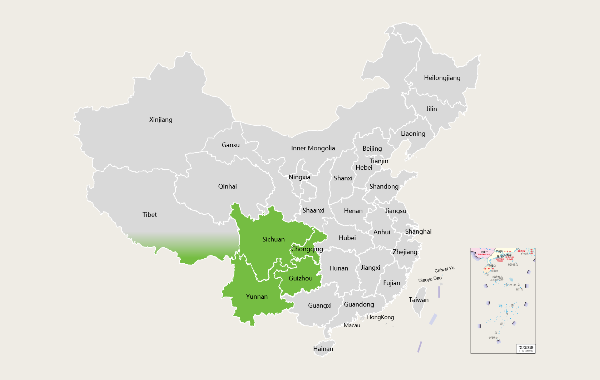
· Core Famous Teas:
· Sichuan Zhuyeqing (四川竹叶青, Emei Mountain High-Mountain Tea):
Origin: Zhuyeqing tea is produced in the Emei Mountain area of Sichuan Province. Emei Mountain is a famous Buddhist mountain in China, known for its beautiful scenery and rich cultural heritage. The tea trees grow at high altitudes, surrounded by clouds and mist, which gives the tea a unique flavor.
Characteristics: Zhuyeqing tea has a long and slender shape, like bamboo leaves. The tea leaves are green and shiny, with a fresh and mellow aroma. When brewed, the tea infusion is light green and clear, with a sweet and refreshing taste.
Quality Features: The tea is rich in antioxidants, vitamins, and minerals, which have various health benefits, such as improving digestion, reducing fatigue, and enhancing immunity.
Brewing Method: Use about 3 grams of tea leaves for every 150 ml of water. The water temperature should be around 80-85°C. Steep the tea for 2-3 minutes to bring out the best flavor.
Storage Method: Store the tea in an airtight container in a cool, dry place away from direct sunlight and strong odors.
Market Price: Approximately 15-30 USD/100g, depending on the grade and quality.
· Mengding Ganlu(蒙顶甘露, Sichuan):
Origin: Mengding Ganlu tea is produced on Mengding Mountain in Sichuan Province. Mengding Mountain has a long history of tea cultivation, dating back over 2,000 years. It is regarded as the birthplace of tea culture in China.
Characteristics: Mengding Ganlu tea has a curly and tight shape, with white down covering the surface. The tea leaves are green and tender, with a delicate aroma. When brewed, the tea infusion is light green and bright, with a sweet and mellow taste.
Quality Features: Mengding Ganlu tea is known for its high-quality and unique flavor. It contains a variety of beneficial compounds that can help regulate blood pressure, lower cholesterol, and promote cardiovascular health.
Brewing Method: Use about 2-3 grams of tea leaves for every 150 ml of water. The water temperature should be around 75-80°C. Steep the tea for 1-2 minutes initially, and then extend the steeping time for subsequent infusions.
Storage Method: Keep the tea in a sealed container in the refrigerator to maintain its freshness. The ideal storage temperature is between 0-5°C.
Market Price: Around 20-40 USD/100g, depending on the grade and harvest time.
· Duyun Maojian (都匀毛尖, 1915 Panama Gold Medal Tea):
Origin: Duyun Maojian tea is produced in Duyun City, Guizhou Province. It has a long history and was awarded the gold medal at the 1915 Panama Pacific International Exposition, which brought it international recognition.
Characteristics: Duyun Maojian tea has a slender and straight shape, with a white down covering the surface. The tea leaves are green and shiny, with a strong floral aroma. When brewed, the tea infusion is light green and clear, with a fresh and brisk taste.
Quality Features: This tea is rich in polyphenols, catechins, and other antioxidants, which have anti-inflammatory, anti-cancer, and anti-aging effects. It can also help improve sleep quality and relieve stress.
Brewing Method: Use about 3-4 grams of tea leaves for every 150 ml of water. The water temperature should be around 85-90°C. Steep the tea for 2-3 minutes to fully extract the flavor.
Storage Method: Store the tea in an airtight container in a cool, dark place. Avoid exposure to moisture and heat, as they can affect the quality of the tea.
Market Price: Approximately 25-50 USD/100g, depending on the grade and quality.
· Yongchuan Xiuya (永川秀芽, Chongqing)
Origin: Yongchuan Xiuya is produced in Yongchuan District, Chongqing Municipality. The region is located at the junction of the Sichuan Basin and the Yunnan - Guizhou Plateau, with a subtropical monsoon climate. The abundant sunshine, moderate rainfall, and fertile soil in this area provide excellent conditions for the growth of high - quality tea trees.
Characteristics: The tea leaves of Yongchuan Xiuya are slender, straight, and pointed, resembling pine needles. They are green and shiny, with a dense covering of white down on the surface. The tea has a fresh and high - pitched aroma, with floral and fruity undertones. When brewed, the tea infusion is light green and clear, with a delicate and sweet taste that lingers on the palate.
Quality Features: This tea is rich in tea polyphenols, caffeine, and aromatic substances. It has antioxidant, anti - fatigue, and anti - aging effects. Regular consumption can help improve mental alertness, enhance physical strength, and promote overall well - being. It is also known for its ability to lower cholesterol levels and protect the cardiovascular system.
Brewing Method: Use about 2 - 3 grams of tea leaves for every 150 ml of water. The water temperature should be around 80 - 85°C. Let it steep for 1 - 2 minutes for the first brew. For subsequent brews, increase the steeping time slightly each time to fully extract the flavors. It can be brewed 3 - 4 times.
Storage Method: Store the tea in an airtight container, such as a glass jar or a tin can, in a cool, dark place. Avoid exposure to direct sunlight, strong odors, and moisture, as these can degrade the quality of the tea and affect its flavor and aroma.
Market Price: Approximately 15 - 35 USD/100g.
Territory: Guangdong, Guangxi, Fujian, Hainan, Taiwan
Terroir Advantages: These regions enjoy a subtropical or tropical monsoon climate with abundant rainfall and warmth throughout the year, providing optimal conditions for tea tree growth. The rich and diverse soil types contribute to the unique flavors of the tea leaves.
Core Famous Teas: Lingyun Baihao, Tieguanyin
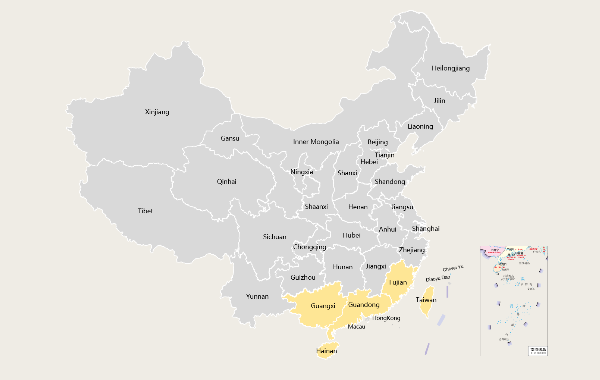
· Lingyun Baihao (凌云白毫, Guangxi)
Origin: It originates from Lingyun County, Baise City, Guangxi Zhuang Autonomous Region.
History: With a long history of cultivation, Lingyun Baihao has been well-known locally for centuries. Its unique processing techniques have been passed down through generations.
Characteristics: The tea leaves are covered with dense white fuzz, giving them a distinctive appearance. They have a strong and refreshing aroma.
Quality Features: The dry leaves are slender, straight, and white like silver needles. After brewing, the tea soup is clear and bright yellow-green, with a mellow and sweet taste that lingers in the mouth.
Brewing Method: Use about 3-5 grams of tea leaves per 150ml of water. Brew with water at around 80-85°C (176-185°F) for 2-3 minutes. Multiple infusions are possible, with each subsequent infusion increasing the brewing time slightly.
Storage Method: Store in an airtight container in a cool, dry, and dark place, away from strong odors.
Market Price: Approximately 15−30 USD/100g.
· Tieguanyin (铁观音, Fujian)
Origin: Originating from Anxi County, Quanzhou City, Fujian Province.
History: It has a history of over 300 years. Through continuous improvement in cultivation and processing techniques, it has become one of the most famous oolong teas in the world.
Characteristics: The tea leaves are heavy and solid, with a distinct orchid fragrance. The aroma is long-lasting and the taste is rich and complex.
Quality Features: The dry leaves are curled into small granules, resembling iron cakes. After brewing, the leaves unfurl gradually, revealing their beautiful shape. The tea soup is golden yellow and bright, with a mellow and sweet flavor.
Brewing Method: Use about 7-8 grams of tea leaves per 150ml of water. Brew with boiling water (around 100°C or 212°F) for about 30 seconds to 1 minute for the first infusion, and then increase the brewing time slightly for subsequent infusions.
Storage Method: Keep in an airtight container in a cool, dry place. It can also be stored in the refrigerator for long-term preservation, but make sure to seal it properly to prevent moisture and odor absorption.
Market Price: Ranges from 20−80 USD/100g, depending on the quality and grade.
Territory: Zhejiang, Southern Anhui, Jiangxi, Hubei
Terroir Advantages: The hilly terrain with distinct four seasons and nourishing cloud and mist provides tender and fresh green tea tree buds and leaves, resulting in tea with an elegant and long-lasting aroma.
Core Famous Teas: West Lake Longjing, Biluochun, Anji White Tea, Huangshan Maofeng, Enshi Yulu
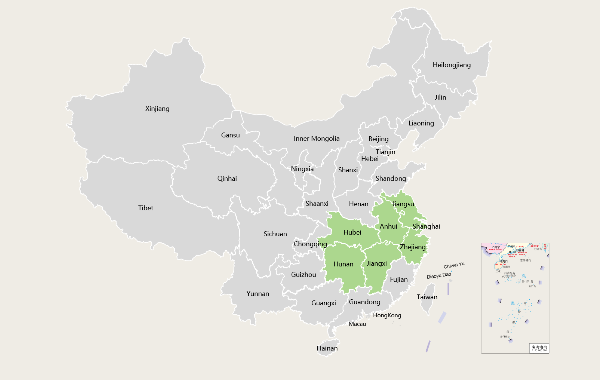
· West Lake Longjing (西湖龙井, Zhejiang)
Origin: It is produced in the areas around West Lake in Hangzhou City, Zhejiang Province, especially famous in Longjing Village, Shifeng Mountain, etc.
History: With a history of over 1,200 years, it has been a tribute tea since the Tang Dynasty. Its unique processing techniques and high quality have made it a symbol of Chinese green tea.
Characteristics: The tea leaves are flat, straight, and smooth, resembling sword blades. It has a fresh and chestnut-like aroma, with a mellow and sweet taste.
Quality Features: The dry leaves are yellow-green and shiny, with a delicate and uniform shape. After brewing, the tea soup is clear and bright green, with a long-lasting aftertaste.
Brewing Method: Use about 2-3 grams of tea leaves per 150ml of water. Brew with water at around 75-80°C (167-176°F) for 2-3 minutes. It is best to use a glass teapot to appreciate the beautiful shape of the tea leaves during brewing.
Storage Method: Store in an airtight container in a cool, dry, and dark place, away from strong odors. It can also be stored in the refrigerator for short-term preservation, but make sure to seal it properly.
Market Price: Ranges from 30−150 USD/100g, depending on the grade and origin.
· Biluochun (碧螺春, Jiangsu, though within the general Jiangnan area)
Origin: Originating from Dongting Mountain in Suzhou City, Jiangsu Province.
History: It has a history of over 1,000 years. During the Qing Dynasty, it became a tribute tea and gained wide recognition for its unique flavor and appearance.
Characteristics: The tea leaves are curled into a spiral shape, resembling snails. It has a strong and floral aroma, with a fresh and sweet taste.
Quality Features: The dry leaves are green with white hairs, giving them a silvery appearance. After brewing, the tea soup is clear and bright green, with a rich and complex flavor.
Brewing Method: Use about 3-5 grams of tea leaves per 150ml of water. Brew with water at around 80-85°C (176-185°F) for 2-3 minutes. Multiple infusions are possible, with each infusion revealing different flavor layers.
Storage Method: Keep in an airtight container in a cool, dry place, away from direct sunlight and strong odors.
Market Price: Approximately 20−60 USD/100g.
· Anji White Tea (安吉白茶, Zhejiang)
Origin: It comes from Anji County, Huzhou City, Zhejiang Province.
History: Although called "white tea," it is actually a green tea variety. It was discovered in the 1980s and has quickly gained popularity due to its unique appearance and taste.
Characteristics: The tea leaves are light green when young and turn white as they mature, which is a rare natural mutation. It has a fresh and delicate aroma, with a sweet and mellow taste.
Quality Features: The dry leaves are straight and slender, with a white and green color. After brewing, the tea soup is pale yellow and clear, with a long-lasting aftertaste.
Brewing Method: Use about 3-5 grams of tea leaves per 150ml of water. Brew with water at around 75-80°C (167-176°F) for 2-3 minutes. It is suitable for multiple infusions to fully enjoy its flavor.
Storage Method: Store in an airtight container in a cool, dry, and dark place, away from moisture and strong odors.
Market Price: Ranges from 15−40 USD/100g.
· Huangshan Maofeng (黄山毛峰, Anhui)
Origin: Produced in the Huangshan Mountain area in Huangshan City, Anhui Province.
History: With a history of over 120 years, it has been a well-known green tea since the Qing Dynasty. The unique geographical environment of Huangshan Mountain contributes to its high quality.
Characteristics: The tea leaves are slender and curved, with a peak-like shape. It has a fresh and orchid-like aroma, with a mellow and sweet taste.
Quality Features: The dry leaves are green with a slight yellow tint, and are covered with fine white hairs. After brewing, the tea soup is clear and bright yellow-green, with a long-lasting aftertaste.
Brewing Method: Use about 3-5 grams of tea leaves per 150ml of water. Brew with water at around 80-85°C (176-185°F) for 2-3 minutes. Multiple infusions can bring out different flavor characteristics.
Storage Method: Keep in an airtight container in a cool, dry place, away from direct sunlight and strong odors.
Market Price: Approximately 20−50 USD/100g.
· Enshi Yulu (恩施玉露, Hubei)
Origin: Originating from Enshi Tujia and Miao Autonomous Prefecture in Hubei Province.
History: It has a history of over 300 years. It is one of the few steamed green teas in China, with a unique processing method.
Characteristics: The tea leaves are slender and straight, resembling pine needles. It has a fresh and seaweed-like aroma (a unique characteristic of steamed green teas), with a mellow and sweet taste.
Quality Features: The dry leaves are green and shiny, with a uniform shape. After brewing, the tea soup is clear and bright green, with a long-lasting aftertaste.
Brewing Method: Use about 3-5 grams of tea leaves per 150ml of water. Brew with water at around 75-80°C (167-176°F) for 2-3 minutes. Multiple infusions are possible to fully experience its flavor.
Storage Method: Store in an airtight container in a cool, dry, and dark place, away from moisture and strong odors.
Market Price: Approximately 15−35 USD/100g.
Territory: Northern Anhui, Henan, Shandong
Terroir Advantages: The cold climate tempers the inner quality of the tea trees, resulting in tea with a strong aroma and extremely high endurance for multiple infusions, with a lingering fragrance even after seven infusions.
Core Famous Teas: Liuan Guapian, Xinyang Maojian, Taiping Houkui
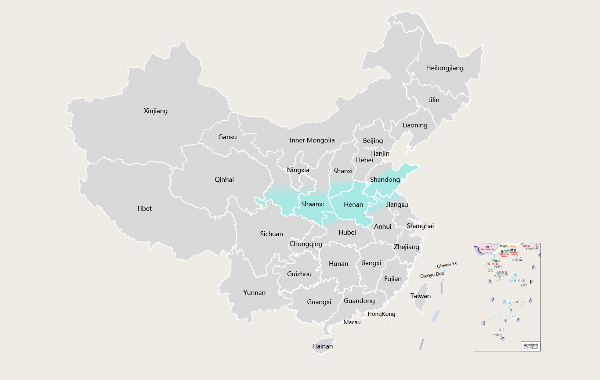
· Liuan Guapian (六安瓜片, Anhui)
Origin: It is produced in Liuan City, Anhui Province, especially famous in the Jinzhai and Huoshan counties.
History: With a history of over 100 years, it is a unique green tea that uses only the second leaf of the tea shoot, without the bud and the third leaf.
Characteristics: The tea leaves are shaped like melon seeds, flat and straight. It has a strong and chestnut-like aroma, with a mellow and sweet taste.
Quality Features: The dry leaves are green and shiny, with a uniform shape. After brewing, the tea soup is clear and bright yellow-green, with a long-lasting aftertaste.
Brewing Method: Use about 3-5 grams of tea leaves per 150ml of water. Brew with water at around 85-90°C (185-194°F) for 2-3 minutes. Multiple infusions can bring out different flavor notes.
Storage Method: Keep in an airtight container in a cool, dry place, away from direct sunlight and strong odors.
Market Price: Approximately 20−50 USD/100g.
· Xinyang Maojian (信阳毛尖, Henan)
Origin: Originating from Xinyang City, Henan Province, especially famous in the Shihe District and Pingqiao District.
History: It has a history of over 2,300 years. It has been a tribute tea since the Tang Dynasty and is well-known for its high quality and unique flavor.
Characteristics: The tea leaves are thin, straight, and white - tipped. The white hairs on the leaves are a sign of freshness and high quality. It has a strong and fresh aroma, with a hint of floral and fruity notes. The taste is mellow, sweet, and slightly astringent, which gives it a refreshing feeling.
Quality Features: The dry leaves are green with a dense covering of white hairs, giving them a silvery appearance. After brewing, the tea soup is clear and bright green. The leaves in the cup stand upright initially and then gradually sink, which is a beautiful sight. The aroma is long - lasting, and the taste is rich and complex.
Brewing Method: Use about 2 - 3 grams of tea leaves per 150ml of water. Warm the teapot and teacups first. Put the tea leaves into the teapot and pour water at around 75 - 80°C (167 - 176°F) over them.
Market Price: Ranges from 15−40 USD/100g.
· Taiping Houkui (太平猴魁, Huangshan)
Origin: It is produced in Huangshan District (formerly Taiping County) in the southern part of Anhui Province. The area is surrounded by mountains, with abundant cloud and mist, which provides a unique micro - climate for tea tree growth.
History: Taiping Houkui has a history of more than 100 years. It was created in the early 20th century(1859 years) and quickly gained a reputation for its exceptional quality. Its production process is very particular, involving hand - picking and special processing techniques.
Characteristics: The tea leaves are large, flat, and straight, with two leaves holding a tender bud in the middle, resembling a monkey's paw, hence the name "Houkui" (Monkey King). It has a strong and orchid - like aroma, which is very elegant and long - lasting. The taste is mellow, sweet, and smooth, with a refreshing aftertaste.
Quality Features: The dry leaves are green and shiny, with a uniform shape. After brewing, the tea soup is clear and bright yellow - green. The leaves in the cup gradually expand, showing their full form. The aroma is rich and pure, and the taste is well - balanced and full - bodied.
Brewing Method: Use about 3 - 5 grams of tea leaves per 150ml of water. Warm the glass teapot (glass is preferred to appreciate the shape of the leaves) with hot water. It can be brewed 3 - 5 times, and each infusion can bring out different flavor nuances.
Storage Method: Store the tea in an airtight container in a cool, dry, and dark place, away from direct sunlight, heat, and strong odors.
Market Price: Approximately 30−70 USD/100g. High - grade Taiping Houkui from the core production areas can be more expensive.
What Our Clients Say?
Based on 10,000+ traveler reviews












